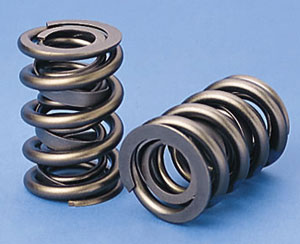With the many choices of aftermarket cylinder heads, most with "longer-than-stock" length valves, the recommendation of a specific spring for a specific cam is almost impossible.

It is now necessary to select the spring that will best fit the cylinder head configuration. The following information is offered as a guideline only.
1) Flat Tappet cam/lifter applications (Street and Street/Strip) seat pressures:
A. Small Block 105-125 lbs. seat pressure.
B. Big Block 115-130 lbs. seat pressure (Note: Big Block applications need higher seat pressures due to their larger, heavier valves).
2) Flat Tappet open pressures should not exceed 330 lbs. open pressure (sustained after spring break-in) for acceptable cam and lifter life.
A. Open pressures should be a minimum of 220 lbs. for applications up to 4,000 rpm.
B. For good performance above 4,000 rpm, open pressures should be at least 260 lbs. with stock weight valves (light weight valves require less spring open pressure).
C. Spring open pressures over 280 lbs. can cause "pressed-in" studs to come loose; therefore, screw-in studs are recommended for open pressures above 280 lbs.
Source: Crane Cams.













